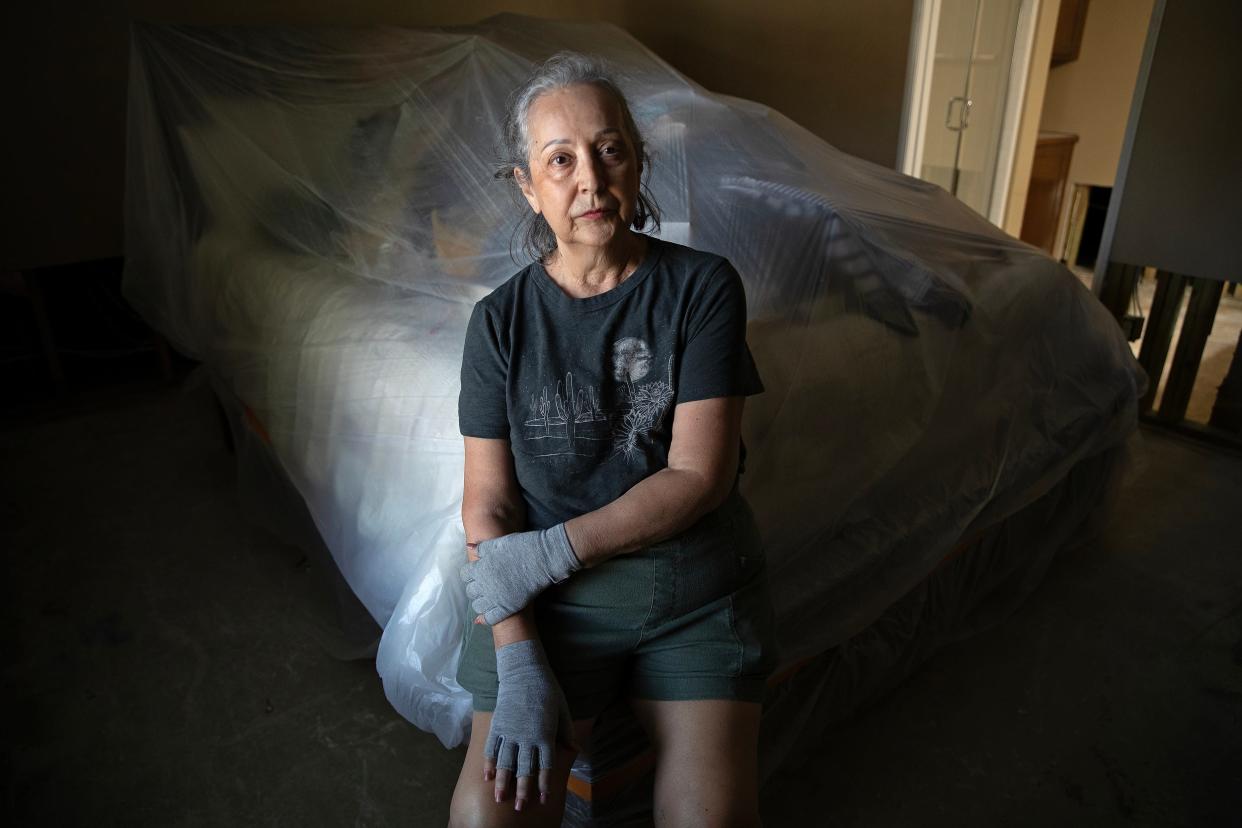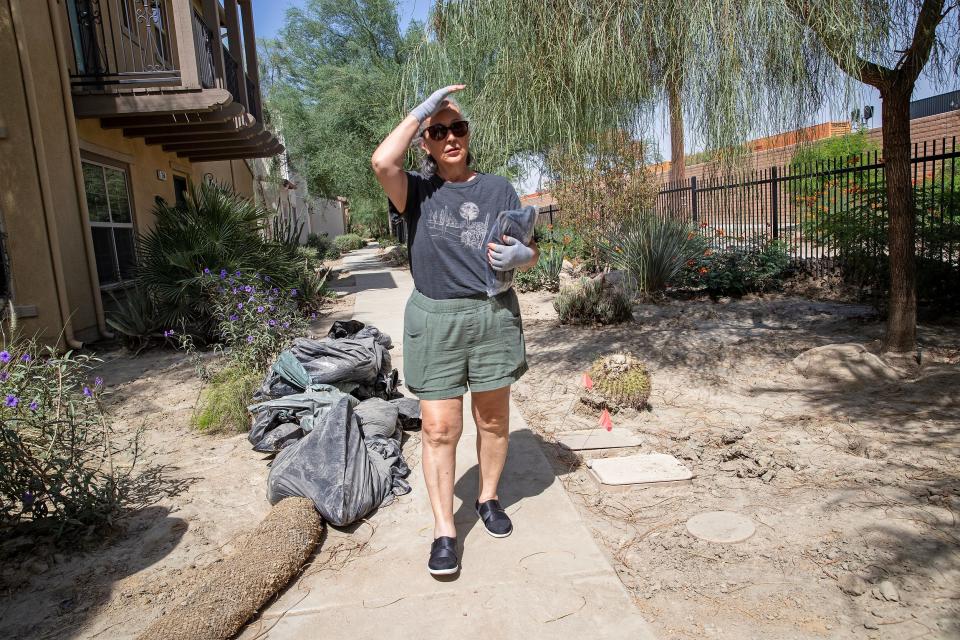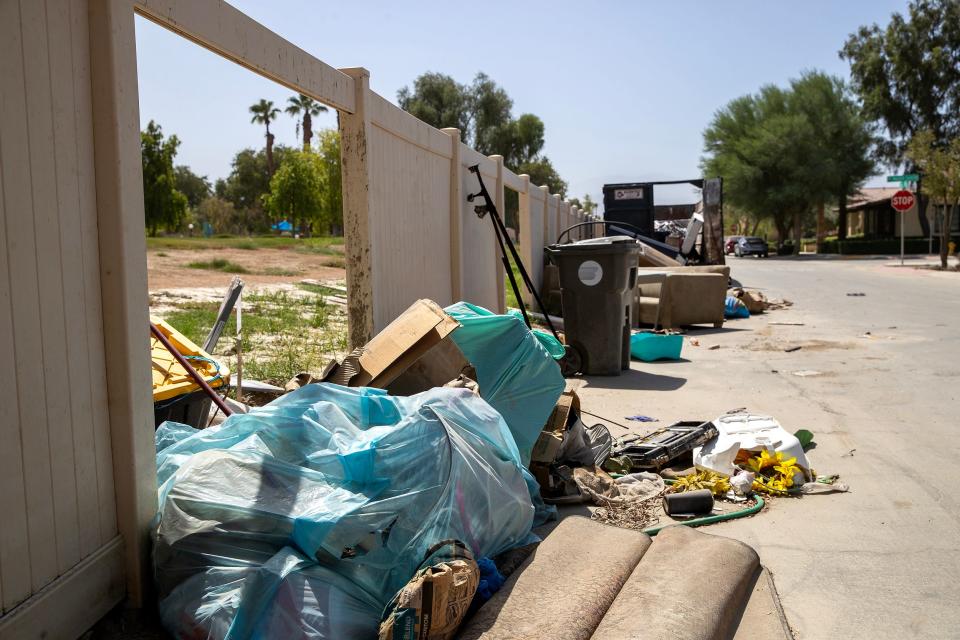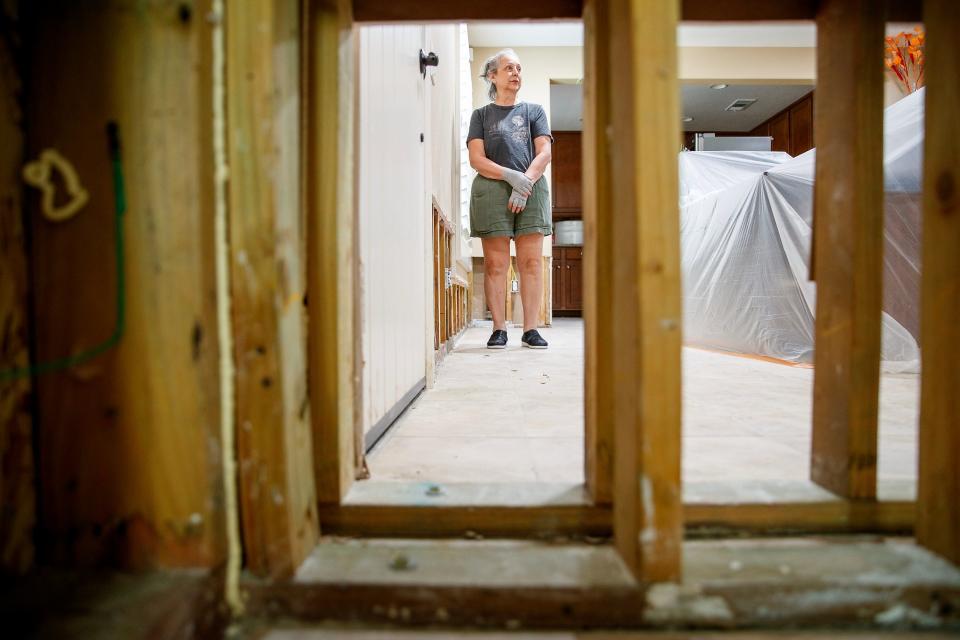A month after Hilary, people in hard-hit Palm Desert neighborhood still looking for help

Standing outside her home in Palm Desert’s Spanish Walk neighborhood on a recent dusty morning, Lydia Duran recalled being “super, super happy” in her time living there — until Tropical Storm Hilary struck.
Duran bought a first-floor condo in the community nestled between Gerald Ford Drive and Interstate 10 last year, so before the historic deluge in August, she hadn’t seen any major storms in her brief time in the desert. The neighborhood north of Frank Sinatra Drive, which sits directly across the interstate from Acrisure Arena, also falls outside of any FEMA-designated high-risk flood zones, offering some degree of reassurance.
But as the rain poured in the Coachella Valley on Aug. 20 and 21, Duran began getting texts from her upstairs neighbors about the street flooding outside. Soon, mud and rainwater started to seep in through her garage and front door.
As muddy water began to creep into her entire living room and kitchen, she first evacuated her dog, a King Charles spaniel named Lima, to a neighbor through one of her windows. Duran, who is 68 and has arthritis that hinders her mobility at times, waited for first responders to help her leave through the front door.
A month after the storm, Duran — along with a handful of other residents — remains displaced. After spending several weeks at a nearby Residence Inn, where another Spanish Walk resident was still staying as of this week, Duran moved into a rental casita outside her neighborhood for now.
Duran, who came to Palm Desert from Rancho Cucamonga, doesn’t know when or even whether she’ll move back into her home, where the insulation was still showing last week after about 2 feet of drywall had to be removed due to the flood damage.
Because she didn't have flood insurance, Duran has paid out of pocket for everything so far — from her temporary lodging to the drywall removal — at an estimated cost of around $15,000. She expects it would require upwards of $100,000 to fully rebuild her condo.
“I moved out to this area because this is where I wanted to retire,” Duran, 68, said. “Now, I don’t know if I’m going to be able to retire.”

Duran estimates she’s among about 10 residents from the community who are still fully displaced from the storm, while others continue cleaning up the damage. With no federal relief aid issued so far, the residents are stuck in limbo, still reeling from Hilary a month later.
As they wonder if disaster aid will ever come, Duran and some others are weighing whether to stay and rebuild — or move away. Meanwhile, the city of Palm Desert and the regional water district are working to lessen the impacts of future storms.
More: In Hilary’s wake, many residents still frustrated and angry at Cathedral City’s response
Is a federal disaster proclamation coming?
Hilary wreaked havoc across the desert, causing major damage to crucial roads and unleashing a wall of mud on homes in Cathedral City’s Panorama neighborhood. Across Riverside County, the storm’s initial damage estimate was over $126 million, largely concentrated in the Coachella Valley.
Since then, state and federal officials have been pushing President Joe Biden to issue a major disaster proclamation for California due to the August storm — which would then open up a range of emergency loan and funding programs run by the Federal Emergency Management Agency.
Gov. Gavin Newsom requested the declaration in early September, and California’s entire congressional delegation reiterated the request in a letter to the president Sept. 19. It’s unclear precisely when — or if — a federal disaster proclamation could be issued, as they vary widely depending on the natural disaster.
“There’s no deadline, so they take as long as they take, and we do everything we can to prepare a convincing and compelling request,” Riverside County Emergency Management Department spokesperson Shane Reichardt said in an interview.
“When you have things like a Maui-type (wildfire) incident going on, obviously, you have a significant loss of property, loss of life — it's international news,” Reichardt added. “I certainly don't want to make light of what we incurred, but it pales in comparison to what we saw in Maui. ... It is a challenge when we're competing for that (funding).”
FEMA officials have surveyed the valley’s most-impacted areas, Reichardt said, and the county is communicating with federal and state officials constantly “to make sure that we don’t fall off the radar.”
A few other programs, such as a Small Business Administration loan program and a county-level property tax relief program, have been started recently for residents dealing with storm damage. But many forms of federal aid hinge on the presidential disaster declaration.
Deciding whether to stay or go

In Spanish Walk, the decision on federal aid likely will determine what some residents do next. The neighborhood does not fall into one of FEMA’s high-risk flood zones, though much of the area just across the interstate does.
Given her home’s place on the flood maps, Duran says her insurance company did not require her to purchase flood insurance, so she opted against it, adding that others in Spanish Walk face similar predicaments.
More: Hilary's aftermath: Check if your neighborhood is at risk for flooding in future rainstorms
If federal disaster aid is approved, FEMA officials will determine which relief programs to make available to residents, and Reichardt said it’s hard to guess which ones could be activated.
“Some of that is trying to figure out which programs people fit best with,” Reichardt said. “What I caution is that it's not going to replace everything that people have lost and make them 100% whole.”
Palm Desert officials have also been pushing for federal funding, City Manager Todd Hileman told The Desert Sun, and they’ve been discussing other relief possibilities with local banks.
“Right now, we don't have any formal programs for housing assistance or to help them rebuild, so we're very much reliant on the federal declaration being declared so we can bring some additional dollars to the community,” Hileman said.
Spanish Walk flooding caused by breached channel
The mud and flooding that came into parts of Spanish Walk was caused by overflowing from a mid-valley diversion channel that starts just west of Palm Desert and extends through the city, running alongside the Union Pacific railroad and Interstate 10.
Hilary marked the first time that the channel was breached. On Monday afternoon of the storm, the city teamed with a local construction company to build a dam to stymie the waterflow. City-hired crews also worked through the week to remove mud and water in Spanish Walk’s streets and parks, which are typically managed by the HOA.
The city spent roughly $200,000 on the cleanup efforts at Spanish Walk, part of about $1.76 million in storm-related emergency funds approved by the city council earlier this month.
Five buildings in Spanish Walk that held about 30 units also were temporarily red-tagged — meaning they were deemed unsafe to enter — due to potential electrical hazards caused by the flooding. Those electrical issues were largely resolved by later in the week of the storm.
The city initially teamed with the Red Cross to offer temporary shelter at a site in Thermal, but Hileman said their work with the nonprofit was essentially at a “standstill” last week. While grateful for the city’s funding and work to remove the neighborhood’s mud and water, Duran was frustrated by the city saying it was offering housing as she continued to pay for her temporary lodging.
Hileman said city officials have learned that some of the systems they relied on after the storm were "more referral in nature than compensatory."
“I think that's been one of the things that has been difficult to understand from the residents’ perspective is there's just not anywhere where there's ready cash available to help them monetarily like that," Hileman said.
Hileman didn’t have a count of the exact number of homes that were significantly damaged, but said they were mostly ground-floor units. The Spanish Walk neighborhood, which has 338 homes built so far, is a mix of single-family homes, second-and-first-floor condominiums, quadplexes and duplexes. The neighborhood is young compared to others nearby, with most of the condos developed in phases between 2008 and 2018.
The city didn’t have an estimate of how many residents are still living elsewhere due to the storm damage. The neighborhood’s HOA didn’t have a precise count either, according to Hileman.
Palm Desert aiming to avoid any repeats
While much of the city saw less extensive damage — in part thanks to millions in property taxes earmarked for flood retention efforts since the 1980s — Palm Desert officials have started discussing ways to bolster the mid-valley stormwater channel that overflowed. The city has an engineering assessment underway that will look at what happened to the channel and offer some guidance on next steps.
“It's starting out with — How much rain did we get? Where did it flood significantly? Who do we need to bring in and talk to? Because we do think there's some things we can do internally within the city, but we're really the recipient of all the water upstream,” Hileman said.
Hileman said the city could discuss some upgrades with the Coachella Valley Water District and neighboring cities that the channel also runs through, such as Cathedral City and Rancho Mirage.
Palm Desert officials are also currently reaching out to some property owners near the interstate to see if they would be open to selling some land to the city that could be used to add capacity and bring relief to the channel west of Spanish Walk, Hileman said.
“If we do acquire additional property, can we get the mid-valley channel capacity, for instance, to a 500-year event? Something like that,” Hileman said. “But it's important to remember that only a portion of that channel is in Palm Desert.”
As the city begins to weigh where it can enhance its drainage, three other CVWD projects — ones for north Cathedral City, Thousand Palms, and north Indio — are in the works that will help direct water flows from land north of I-10 through designated channels into the Whitewater River Stormwater Channel.
The discussions about flood infrastructure upgrades also come as more than 4,500 new housing units have either gained city approval or are under development in the north end of Palm Desert.
Next to Spanish Walk, a 150-unit affordable housing development has gained city approval and is currently in progress. City officials said the project is planned to connect with Spanish Walk’s drainage system and divert flows east of the neighborhood toward Freedom Park.
An uncertain timeline
As a train roared by on the adjacent Union Pacific tracks during a recent morning at Spanish Walk, Duran surveyed the damage to another resident’s home off Paseo Drive, the street closest to the channel that saw the brunt of the damage. None of the home's furniture or interior décor was salvageable after the storm, and full sheets of drywall had been removed but were yet to be replaced a month after the storm.
While still uncertain of her long-term future, Duran said things were “working out OK” in her new space. She recently moved her dog Lima, who she said has been “a good support girlie,” into her rental casita, bringing her some added daily joy.
But a month removed from the storm, she and other residents still wonder how the flooding could have happened to them. Duran learned one lesson the hard way, as she bought flood insurance for herself the day after the storm came through.

In an optimistic scenario, Duran thinks she could move back into her home within six months. But if the federal aid never arrives, Duran doesn’t know where she could get the money to rebuild. She mentioned possibly getting the “bare essentials” redone in her home by using her retirement money.
“But then when time comes to retire, I’m not going to be able to retire here, because I can’t afford it anymore,” Duran said of that scenario. “So, I still would have to sell it anyway and get out from under it somehow.”
Tom Coulter covers the cities of Palm Desert, La Quinta, Rancho Mirage and Indian Wells. Reach him at thomas.coulter@desertsun.com.
This article originally appeared on Palm Springs Desert Sun: Hilary hit a Palm Desert neighborhood hard, leaving residents in limbo

